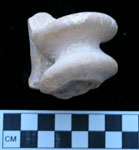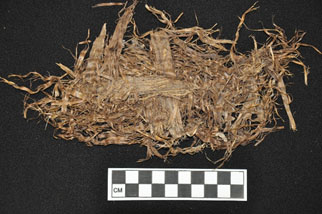BIGHORN REGION ROCKSHELTERS
Human use of the Bighorn shelters appears to date to the earliest occupation of the North American continent. In the Bighorn region we are asking questions about the earliest occupants of the shelters as well as 'productivity', intensity, nature of occupation, and paleoclimactic conditions of the late Quaternary. Ditch Creek Shelter has yielded a Clovis point although any associated occupation still eludes us, while the Two Moon Shelter has a solid Folsom component. Last Canyon Cave is yielding abundant organic material, in the form of bone and animal pellets, dating to 80,000 years ago in a continuous sequence useful for paleoclimactic reconstruction, as well as human use of the shelter over the past several thousand years. Pleistocene horse and caribou have been recovered in the approximately 13,000 year old sediment at this site and a fragment of juniper sandal was found near site surface.
 |
 |
 |
||
Clovis point (Left), Pleistocene horse astragalus (center), juniper bark sandal fragment (right).

